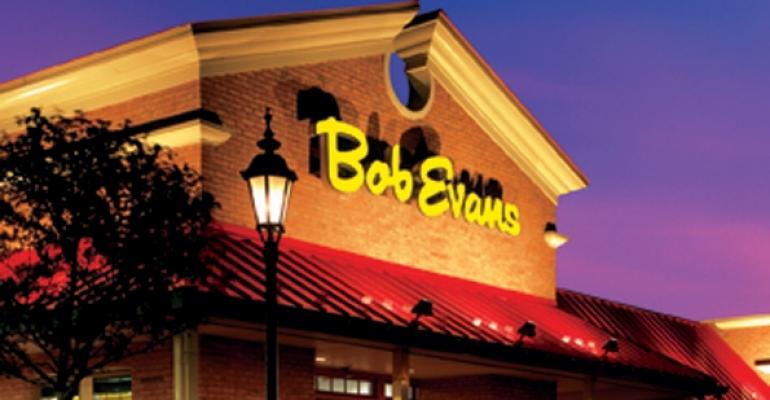An investment group holding more than 5 percent of Columbus, Ohio-based Bob Evans Farms Inc. is calling upon the family-dining operator to unlock shareholder value by splitting up the company and selling of millions of dollars of real estate.
New York-based Sandell Asset Management, which owns about 1.4 million shares of Bob Evans Farms for a 5.1-percent stake of the company, said in a letter delivered to the company’s board on Tuesday morning that the company was “materially undervalued.”
The investment firm’s letter laid out a three-step proposal that begins with the separation of the company’s 560-unit restaurant division from its Bob Evans Foods segment by selling or spinning off the packaged-goods company. The next step would be a massive sale-leaseback transaction for the real estate parcels that hold the brand’s restaurants, which are all company-owned.
“We believe that Bob Evans suffers from a conglomerate discount as a result of the company’s two disparate business segments,” Thomas E. Sandell, chief executive of Sandell Asset Management, wrote in the letter to Bob Evans’ board of directors. “Due in part to this conglomerate structure … the company has traded at a perennial discount to its restaurant peers and at an even greater discount to companies in the packaged-foods space.”
RELATED
• Bob Evans sales, profit tumble in 1Q
• Bob Evans to finish remodels by end of fiscal 2014
• More Bob Evans news
Bob Evans acknowledged that it received Sandell’s letter but declined to comment.
Sandell also expressed disappointment with Bob Evans’ “relative underperformance” compared with the growth of Cracker Barrel’s stock price over the past three to five years. Further, he said his firm was “alarmed” by the degree to which board directors deferred to Bob Evans’ management, including chief executive Steve Davis.
“The recent four-year extension to Mr. Davis’ employment agreement is an ill-justified reward for the company’s disappointing relative performance,” Sandell wrote, “particularly in light of the fact that Mr. Davis oversaw the poor results of the Mimi’s Café restaurant chain for almost six years before the company finally divested the business at a significant loss this year.”
Sandell estimated that the hypothetical Bob Evans Foods spinoff and sale-leaseback transactions could generate approximately $1.08 billion in proceeds, which could enable the third step of repurchasing shares for $58 per share.
Bob Evans’ share price closed at $57.02 per share on Sept. 23. During morning trading on Sept. 24, the company’s share price opened up at $57.17 per share and rose sharply, approaching its 52-week high of $60.22 per share.
Sandell further estimated that a post-spinoff, post-sale-leaseback Bob Evans Farms could be valued between $73 and $84 per share.
“It is likely that Bob Evans, as a pure-play restaurant company with a completely upgraded store base and positive operating prospects, could trade at a multiple comparable to or in excess of other publicly-traded family-dining companies,” Sandell wrote. “It is important to note that the plan that we are advocating does not involve sweeping cost-reduction measures but rather is financial in nature and wholly within the control of the company."
Stephen Anderson, restaurant securities analyst for Miller Tabak + Co., said in an interview that the shareholder letter likely would have no impact.
“We’re of the camp that [Bob Evans Farms is] not going to do anything,” he said. “That real estate alone is worth close to $700 million, and they’re in it for the long haul. After about 12 years, the rent and lease payments would equal more than the value of the land [Bob Evans holds].”
In recent meetings with securities analysts, Bob Evans’ management had pointed out that the company recently had sold the real estate for underperforming restaurants the chain decided to close, Anderson added. “If you own your assets, it’s much easier to sell the land and buildings when a unit is underperforming,” he said.
Anderson also pushed back on Sandell’s charge that Bob Evans’ stock price was too undervalued because the food segment and restaurant segment obfuscate their combined underlying value.
“If you look at Bob Evans relative to Cracker Barrel, it has close to the same multiple,” he said. “The food products portion has a little higher multiple because they’re out there purchasing other manufacturers like Kettle Creations. There might be a slight premium there. And value could be added from the franchising and licensing of Bob Evans Express.”
The company had announced the formation and first licensing agreement for Bob Evans Express during its earnings call for the first quarter of fiscal 2014. Executives said that the concept would allow the brand to expand its footprint in nontraditional and on-site locations.
Bob Evans’ 560 family-dining restaurants operate in 19 states.
Contact Mark Brandau at [email protected].
Follow him on Twitter: @Mark_from_NRN





